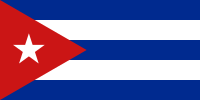Simplify multicoloured batik by directly painting on Procion MX dye
Name: Hector
Country or region: USA
Message: First of all thank you very much for your informative and easy to follow instructions on the art of batiking. As I'm sure you're aware, information on this topic is very limited.
I dabbled briefly in batik many years ago and I'm trying to familiarize myself with it again.
My question is this: I'm attempting the tub method of waxing and dyeing and my project is a Cuban flag mixing red and blue. The triangle is red and three of the stripes are blue. If I don't wax the blue initially (along with the white) and dye the red then if I apply the blue (unwaxed) it will obviously be green.
 What I have tried and am in the process of doing, which is quite cumbersome, is waxing all the white and blue stripes, dyeing the red, removing the wax from the white and blue, rewaxing the white and now the red, and then dyeing the blue, wheeew! Do you have any suggestions? All the projects I did before had a progressive color so I didn't have this concern. I hope this makes sense to you, Any help will be appreciated, thank you!
What I have tried and am in the process of doing, which is quite cumbersome, is waxing all the white and blue stripes, dyeing the red, removing the wax from the white and blue, rewaxing the white and now the red, and then dyeing the blue, wheeew! Do you have any suggestions? All the projects I did before had a progressive color so I didn't have this concern. I hope this makes sense to you, Any help will be appreciated, thank you! I think you should consider directly painting on the dye color, instead of immersion dyeing by covering the entire piece with each color of dye in turn. This is a popular method for batik now that we have excellent dyes to use this way.
You could wax the white areas, then paint on thickened blue Procion MX dye for the stripes, let it dry completely, then paint on the thickened red Procion MX dye. You could apply wax over the edge of the blue before applying the red, to reduce the risk of some of the dye creeping over to make purple. (Red and blue mix together to make purple, not green.) Or, instead of waxing, you can use thickened dye to paint with no batik wax at all, but it won't give the batiked texture, and without wax you have to be more careful at the edges where the colors meet.
Since this dye is set with soda ash, either the fabric should be presoaked in the soda ash and allowed to dry before applying the dye, or you should add the soda ash directly to the dye immediately before painting it on. (Do this just before use, because the dye stays good for less than an hour after you add the soda ash to it.) Alternatively, you could use a good fabric paint, such as Jacquard Textile Colors, which doesn't need soda ash to set it, but which needs to be heat-set after it dries by pressing it with a hot iron or putting it into a commercial clothes dryer (hotter than a home dryer) for half an hour. The dry method of heat-setting works for fabric paint but not for true dyes such as Procion MX.
I'm assuming that you are dyeing cotton. If you're dyeing real silk, the same materials and method will work, but nylon will require different dyes. It's very important to choose your dyes based on the fiber content of your fabric. Polyester material would require an entirely different type of dye and method of dye application.
You can thicken Procion MX dye with a product called sodium alginate. This will make it behave more like paint, so that it does not seep right across the fabric. You can add a little alginate to make a thin dye paint, or a lot of alginate to make a thicker one. There's a recipe on the alginate page in the FAQ section of my website.
It's a good idea to test any new technique, such as the dye painting I am suggesting. Try the method out before doing the full-sized project, if you can, to avoid any surprises.
By the way, I don't recommend the use of direct dyes, such as iDye or Cushing Direct Dye, for batik or any other multi-color piece, because direct dyes tend to bleed onto the wrong areas when they are washed. The same is true of all-purpose dyes. Procion MX fiber reactive dyes are idea for batik because they can be used in room-temperature water, so there's no need to risk melting the wax, and they are much more wash-resistant than direct or all-purpose dye.
(Please help support this web site. Thank you.)
Posted: Monday - March 05, 2012 at 10:51 AM
Follow this blog on twitter here.
Quick Links
- All About Dyes & Dyeing Top -
- Top of this blog -
- FAQ -
- The Dye Forum -
- How to Tie Dye - How to Batik -
- Books - Toys - Plants -
- Top of this blog -
- FAQ -
- The Dye Forum -
- How to Tie Dye - How to Batik -
- Books - Toys - Plants -
More in this category:
- -
Statistics
Total entries in this blog:
Total entries in this category:
Published On: Aug 29, 2012 02:49 PM
Total entries in this category:
Published On: Aug 29, 2012 02:49 PM